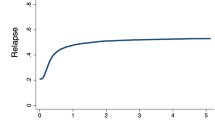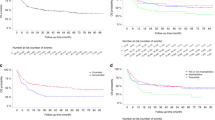Summary:
Although continued advances have been made in the treatment of acute myeloid leukemia (AML), approximately 20–30% of patients will never achieve a remission. For these patients with primary refractory AML, the only curative option remains an allogeneic stem cell transplant. Allogeneic transplantation provides the ability to administer myeloablative doses of chemotherapy or chemoradiotherapy, as well as the advantage of a possible graft-versus-leukemia effect. Difficulty in interpreting the literature is due to selection bias, in particular, the varying definitions of primary refractory disease with respect to the morphological criteria and the number of induction regimen required before being defined as being refractory. Regardless, it is a procedure with high treatment-related mortality and risk of relapse. Most studies demonstrate an event-free survival of 10–20% at 5 years. Predictive factors of outcome include blast cell count in the marrow, karyotype, the number of prior regimen, age, performance status and availability of a related donor. These prognostic factors should be considered prior to offering allogeneic transplantation for primary refractory AML. Those patients with many favorable prognostic factors and an HLA-matched related donor available would be the best candidate for the procedure. Those with many poor prognostic factors and only an unrelated donor available may be better served by being offered palliation or being enrolled in investigational studies.
This is a preview of subscription content, access via your institution
Access options
Subscribe to this journal
Receive 12 print issues and online access
$259.00 per year
only $21.58 per issue
Buy this article
- Purchase on Springer Link
- Instant access to full article PDF
Prices may be subject to local taxes which are calculated during checkout
Similar content being viewed by others
References
Thomas ED, Buckner CD, Banaji M et al. One hundred patients with acute leukemia treated by chemotherapy, total body irradiation, and allogeneic marrow transplantation. Blood 1977; 49: 511–533.
Grimwade D, Walker H, Oliver F et al. The importance of diagnostic cytogenetics on outcome in AML: analysis of 1612 patients entered into the MRC AML 10 trial. The Medical Research Council Adult and Children's Leukaemia Working Parties. Blood 1998; 92: 2322–2333.
Slovak ML, Kopecky KJ, Cassileth PA et al. Karyotypic analysis predicts outcome of preremission and postremission therapy in adult acute myeloid leukemia: a Southwest Oncology Group/Eastern Cooperative Oncology Group Study. Blood 2000; 96: 4075–4083.
Tallman MS, Andersen JW, Schiffer CA et al. All-trans-retinoic acid in acute promyelocytic leukemia. N Engl J Med 1997; 337: 1021–1028.
Fenaux P, Chastang C, Chevret S et al. A randomized comparison of all transretinoic acid (ATRA) followed by chemotherapy and ATRA plus chemotherapy and the role of maintenance therapy in newly diagnosed acute promyelocytic leukemia. The European APL Group. Blood 1999; 94: 1192–1200.
Soignet SL, Maslak P, Wang ZG et al. Complete remission after treatment of acute promyelocytic leukemia with arsenic trioxide. N Engl J Med 1998; 339: 1341–1348.
Mayer RJ, Davis RB, Schiffer CA et al. Intensive postremission chemotherapy in adults with acute myeloid leukemia. Cancer and Leukemia Group B. N Engl J Med 1994; 331: 896–903.
Goldstone A, Burnett A, Avivi I et al. Secondary acute myeloid leukaemia has a worse outcome than de novo AML, even taking into account cytogenetics and age. AML 10, 11, 12 MRC trials. Blood 2002; 100: 88a.
Horowitz MM, Gale RP, Sondel PM et al. Graft-versus-leukemia reactions after bone marrow transplantation. Blood 1990; 75: 555–562.
Collins Jr RH, Shpilberg O, Drobyski WR et al. Donor leukocyte infusions in 140 patients with relapsed malignancy after allogeneic bone marrow transplantation. J Clin Oncol 1997; 15: 433–444.
Cassileth PA, Harrington DP, Appelbaum FR et al. Chemotherapy compared with autologous or allogeneic bone marrow transplantation in the management of acute myeloid leukemia in first remission. N Engl J Med 1998; 339: 1649–1656.
Zittoun RA, Mandelli F, Willemze R et al. Autologous or allogeneic bone marrow transplantation compared with intensive chemotherapy in acute myelogenous leukemia. European Organization for Research and Treatment of Cancer (EORTC) and the Gruppo Italiano Malattie Ematologiche Maligne dell’Adulto (GIMEMA) Leukemia Cooperative Groups. N Engl J Med 1995; 332: 217–223.
Cheson BD, Cassileth PA, Head DR et al. Report of the National Cancer Institute-sponsored workshop on definitions of diagnosis and response in acute myeloid leukemia. J Clin Oncol 1990; 8: 813–819.
Cheson BD, Bennett JM, Kopecky KJ et al. Revised recommendations of the International Working Group for Diagnosis, Standardization of Response Criteria, Treatment Outcomes, and Reporting Standards for Therapeutic Trials in Acute Myeloid Leukemia. J Clin Oncol 2003; 21: 4642–4649.
Wheatley K, Burnett AK, Goldstone AH et al. A simple, robust, validated and highly predictive index for the determination of risk-directed therapy in acute myeloid leukaemia derived from the MRC AML 10 trial. United Kingdom Medical Research Council's Adult and Childhood Leukaemia Working Parties. Br J Haematol 1999; 107: 69–79.
Forman SJ, Schmidt GM, Nademanee AP et al. Allogeneic bone marrow transplantation as therapy for primary induction failure for patients with acute leukemia. J Clin Oncol 1991; 9: 1570–1574.
Biggs JC, Horowitz MM, Gale RP et al. Bone marrow transplants may cure patients with acute leukemia never achieving remission with chemotherapy. Blood 1992; 80: 1090–1093.
Mehta J, Powles R, Horton C et al. Bone marrow transplantation for primary refractory acute leukaemia. Bone Marrow Transplant 1994; 14: 415–418.
Grigg AP, Szer J, Beresford J et al. Factors affecting the outcome of allogeneic bone marrow transplantation for adult patients with refractory or relapsed acute leukaemia. Br J Haematol 1999; 107: 409–418.
Michallet M, Thomas X, Vernant JP et al. Long-term outcome after allogeneic hematopoietic stem cell transplantation for advanced stage acute myeloblastic leukemia: a retrospective study of 379 patients reported to the Societe Francaise de Greffe de Moelle (SFGM). Bone Marrow Transplant 2000; 26: 1157–1163.
Fung HC, Stein A, Slovak M et al. A long-term follow-up report on allogeneic stem cell transplantation for patients with primary refractory acute myelogenous leukemia: impact of cytogenetic characteristics on transplantation outcome. Biol Blood Marrow Transplant 2003; 9: 766–771.
Zander AR, Dicke KA, Keating M et al. Allogeneic bone marrow transplantation for acute leukemia refractory to induction chemotherapy. Cancer 1985; 56: 1374–1379.
Wong R, Shahjahan M, Wang X et al. Prognostic factors for outcomes of patients with refractory or relapsed acute myelogenous leukemia or myelodysplastic syndromes undergoing allogeneic progenitor cell transplantation. Biol Blood Marrow Transplant 2005; 11: 108–114.
Esteve J, Labopin M, Finke J et al. Allogeneic stem-cell transplantation for patients with de novo acute myeloid leukemia not in complete response: results of a survey from the European Group for Blood and Bone Marrow Transplantation (EBMT). Blood 2004; 104: 633a.
Petersdorf EW, Anasetti C, Martin PJ, Hansen JA . Tissue typing in support of unrelated hematopoietic cell transplantation. Tissue Antigens 2003; 61: 1–11.
Giebel S, Locatelli F, Lamparelli T et al. Survival advantage with KIR ligand incompatibility in hematopoietic stem cell transplantation from unrelated donors. Blood 2003; 102: 814–819.
Cook MA, Milligan DW, Fegan CD et al. The impact of donor KIR and patient HLA-C genotypes on outcome following HLA-identical sibling hematopoietic stem cell transplantation for myeloid leukemia. Blood 2004; 103: 1521–1526.
Bensinger WI, Martin PJ, Storer B et al. Transplantation of bone marrow as compared with peripheral-blood cells from HLA-identical relatives in patients with hematologic cancers. N Engl J Med 2001; 344: 175–181.
Ringden O, Labopin M, Bacigalupo A et al. Transplantation of peripheral blood stem cells as compared with bone marrow from HLA-identical siblings in adult patients with acute myeloid leukemia and acute lymphoblastic leukemia. J Clin Oncol 2002; 20: 4655–4664.
Russell JA, Tran HT, Quinlan D et al. Once-daily intravenous busulfan given with fludarabine as conditioning for allogeneic stem cell transplantation: study of pharmacokinetics and early clinical outcomes. Biol Blood Marrow Transplant 2002; 8: 468–476.
de Lima M, Couriel D, Thall PF et al. Once-daily intravenous busulfan and fludarabine: clinical and pharmacokinetic results of a myeloablative, reduced-toxicity conditioning regimen for allogeneic stem cell transplantation in AML and MDS. Blood 2004; 104: 857–864.
Giralt S, Bensinger W, Goodman M et al. 166Ho-DOTMP plus melphalan followed by peripheral blood stem cell transplantation in patients with multiple myeloma: results of two phase 1/2 trials. Blood 2003; 102: 2684–2691.
Khouri IF, Saliba RM, Hosing C et al. Concurrent administration of high-dose rituximab before and after autologous stem-cell transplantation for relapsed aggressive B-cell non-Hodgkin's lymphomas. J Clin Oncol 2005; 23: 2240–2247.
Pagel JM, Matthews DC, Appelbaum FR et al. The use of radioimmunoconjugates in stem cell transplantation. Bone Marrow Transplant 2002; 29: 807–816.
Matthews DC, Appelbaum FR, Eary JF et al. Phase I study of (131)I-anti-CD45 antibody plus cyclophosphamide and total body irradiation for advanced acute leukemia and myelodysplastic syndrome. Blood 1999; 94: 1237–1247.
Forero A, Weiden PL, Vose JM et al. Phase 1 trial of a novel anti-CD20 fusion protein in pretargeted radioimmunotherapy for B-cell non-Hodgkin lymphoma. Blood 2004; 104: 227–236.
Abi-Habib RJ, Liu S, Bugge TH et al. A urokinase-activated recombinant diphtheria toxin targeting the granulocyte–macrophage colony-stimulating factor receptor is selectively cytotoxic to human acute myeloid leukemia blasts. Blood 2004; 104: 2143–2148.
Wingard JR, Leather H . A new era of antifungal therapy. Biol Blood Marrow Transplant 2004; 10: 73–90.
Spielberger R, Stiff P, Bensinger W et al. Palifermin for oral mucositis after intensive therapy for hematologic cancers. N Engl J Med 2004; 351: 2590–2598.
Krijanovski OI, Hill GR, Cooke KR et al. Keratinocyte growth factor separates graft-versus-leukemia effects from graft-versus-host disease. Blood 1999; 94: 825–831.
Reddy P, Maeda Y, Hotary K et al. Histone deacetylase inhibitor suberoylanilide hydroxamic acid reduces acute graft-versus-host disease and preserves graft-versus-leukemia effect. Proc Natl Acad Sci USA 2004; 101: 3921–3926.
Wadleigh M, DeAngelo DJ, Griffin JD, Stone RM . After chronic myelogenous leukemia: tyrosine kinase inhibitors in other hematologic malignancies. Blood 2005; 105: 22–30.
Kantarjian HM, O’Brien S, Cortes JE et al. Imatinib mesylate therapy for relapse after allogeneic stem cell transplantation for chronic myelogenous leukemia. Blood 2002; 100: 1590–1595.
Wassmann B, Pfeifer H, Stadler M et al. Early molecular response to post-transplant imatinib determines outcome in MRD-positive Philadelphia-positive acute lymphoblastic leukemia (Ph+ALL). Blood 2005 (prepublished online).
Anderson Jr LD, Savary CA, Mullen CA . Immunization of allogeneic bone marrow transplant recipients with tumor cell vaccines enhances graft-versus-tumor activity without exacerbating graft-versus-host disease. Blood 2000; 95: 2426–2433.
Chen BJ, Cui X, Liu C, Chao NJ . Prevention of graft-versus-host disease while preserving graft-versus-leukemia effect after selective depletion of host-reactive T cells by photodynamic cell purging process. Blood 2002; 99: 3083–3088.
Author information
Authors and Affiliations
Corresponding author
Rights and permissions
About this article
Cite this article
Song, K., Lipton, J. Is it appropriate to offer allogeneic hematopoietic stem cell transplantation to patients with primary refractory acute myeloid leukemia?. Bone Marrow Transplant 36, 183–191 (2005). https://doi.org/10.1038/sj.bmt.1705038
Published:
Issue Date:
DOI: https://doi.org/10.1038/sj.bmt.1705038
Keywords
This article is cited by
-
Emerging agents and regimens for treatment of relapsed and refractory acute myeloid leukemia
Cancer Gene Therapy (2020)
-
A multicenter trial of myeloablative clofarabine and busulfan conditioning for relapsed or primary induction failure AML not in remission at the time of allogeneic hematopoietic stem cell transplantation
Bone Marrow Transplantation (2017)
-
Long-term outcomes of allogeneic hematopoietic cell transplantation with intensified myeloablative conditioning for refractory myeloid malignancy
Bone Marrow Transplantation (2016)
-
The Development and Validation of a Decision-Analytic Model Representing the Full Disease Course of Acute Myeloid Leukemia
PharmacoEconomics (2013)
-
Impact of pre-transplant marrow blasts on survival of allogeneic stem cell transplantation in adult acute myeloid leukemia
International Journal of Hematology (2013)



